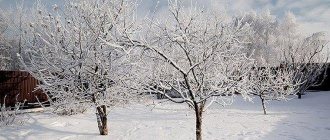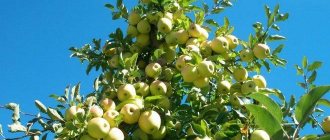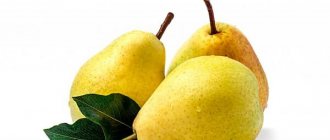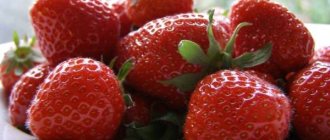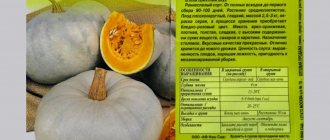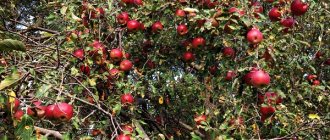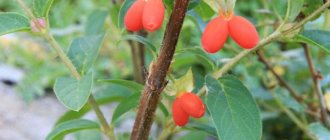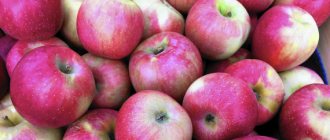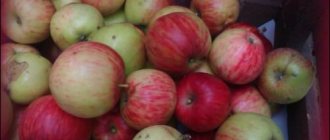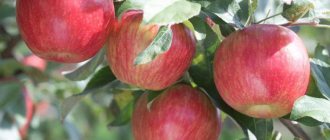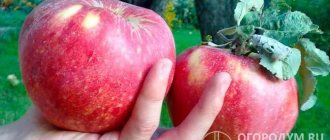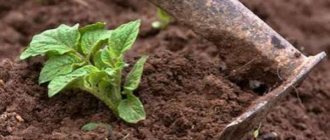Main characteristics
The tree is of moderate size, reaching its maximum in about 6 years. The crown is moderately thick and has the shape of a ball. Without sufficient pruning it may thicken. Young long stems can reach the soil. The fruits are formed on thin annual branches, whose length reaches 15 centimeters. The leaves are small, slightly oblong, matte. They are pointed at the tips.
The bark of an adult individual is colored green-gray, which gradually turns into a more saturated shade.
The variety is not resistant to drought and frost, so it is unsuitable for growing in northern or arid regions.
There are such variants of this culture:
- Cultural winter . Zoned in the Middle and Central zones of Russia, the Volga region and the Moscow region. It is very picky about the chemical composition of the soil and does not tolerate high acidity.
- Creeping . It copes best with difficult winter conditions and is not afraid of frost. This variety requires special care, especially paying attention to pruning.
Subspecies and options
There are several options for growing the variety depending on the region.
Cultural winter
This is a species that can live in the Middle Zone, Central, Moscow Region, Volga Region and abroad. It is important to ensure that the soil on which Pepin grows is neutral. This crop includes the Winter Saffron apple variety.
creeping
A variety that is planted at an angle and bends to the ground. This is done to make growing in harsh conditions possible. Only this variety requires special care and crown formation.
Apple tree Pepin Saffron creeping.
In addition to these types, there are also:
- Volga apple tree Saffron;
- Altaic;
- Summer Saffron;
- apple tree Ural saffron.
These varieties were bred by breeders for regionalization.
Description of fruits
The fruits reach medium sizes, the usual weight is about 90 grams, although they can reach 130. The shape is somewhat flattened and ribbed. The color is greenish-yellow, with red stripes and dots visible on it, but as it is stored the shade becomes orange. Fruit stalks often reach up to 3 centimeters in length and 2 millimeters in thickness.
The surface of the apple is smooth and the skin is dense. As for the taste of the fruit, it is sweet and sour and has a spicy aroma. The pulp is dense and creamy in color. The harvest is rich in sugars and ascorbic acid. The taste and smell are characterized by tasters as very pleasant and rich.
Apples can be eaten fresh or made into juices, marmalade, jam, purees, and so on. They are not bad as a component of salad or baked goods.
Apples tolerate transportation well. Shelf life is 200 days, sometimes more. During storage, the taste characteristics improve, while the presentation is not lost.
Pepin saffron apple tree
The Pepin saffron apple tree is more common in private gardens, having proven itself best as a late-ripening winter variety. It is grown in such regions of Russia as:
- Eastern and Western Siberia;
- Middle Volga region;
- North Caucasus;
- Volgo-Vyatsky district;
- Central and Central Black Earth region;
- In neighboring countries: Georgia;
- Armenia;
- Kazakhstan;
- Belarus;
- Baltics.
Such a wide zoning is the key to unique popularity, however, it should be noted that the need for zoning arose precisely because the vast majority of gardeners in different parts of our country and not only dream of Pepin’s fruits appearing on their table.
Pepin saffron apple tree.
Advantages and disadvantages
If we talk about the main advantages of the variety, it is worth noting the following:
- Precociousness;
- High yield;
- High quality fruits, good transportability and commercial properties;
- Pest resistance.
Among the disadvantages are:
- Poor resistance to scab;
- Demanding on soil growing conditions;
- Harvest heterogeneity.
Morphology
In height, the Pepin saffron apple tree variety can be classified as a medium-sized tree , it can reach a height of 3 m , the crown has a spherical shape , is formed from thin drooping branches of a rich green color with a gray coating, one of the distinctive features is the strong pubescence of the shoots.
The leaves are a rich emerald color with a grayish coating, elliptical in shape, pointed at the end, heavily pubescent, wrinkled.
Flowering of Pepin saffron.
The flowers are snow-white, small, abundantly covering the tree in June .
The fruits are medium and small, weight can range from 90 to 130 g, round in shape, slightly flattened in the center. The skin is thin, but quite dense, smooth, yellow-green in color with a crimson blush throughout the fruit, attached to the fruit twigs and spears with a thin long stalk.
The pulp is a pleasant creamy color, dense, with a sweet and sour taste and a subtle spicy aroma. The tasting rating of the fruit is high.
Important! Apples are high in ascorbic acid and sugars.
Pollinator varieties
The Pepin saffron variety can be called self-fertile , that is, to obtain a harvest there is no special need for planting pollinators, but cross-pollination sharply increases the quantitative indicators of yield. The following can be used as pollinators:
- Antonovka;
- Slavyanka;
- Welsey;
- Calville is snowy.
Antonovka.
Slav.
Welsey.
Calville is snowy.
Winter hardiness and disease resistance
Pepin is characterized by good winter hardiness and adaptive qualities.
As for resistance to the influence of pathogens, it should be noted that there is unsatisfactory resistance to scab. It is necessary to understand this and regularly carry out preventive spraying with biological preparations to combat diseases.
Important! Careful regular inspection of the fruit tree to identify primary signs of disease or the presence of pests can save your green pet. Don't underestimate the importance of visually assessing the condition of the tree!
Pollinator trees
The apple tree of this variety is, in general, self-pollinating and self-fertile. But if you use the optimal pollinator, you can increase the yield quite well. The best varieties are:
- Slav;
- Antonovka;
- Welsey;
- Caliville Snowy.
Slav
Antonovka
Welsey
Apple tree Saffron - description of the variety, general characteristics
The first Saffron was developed in one of the Siberian institutes.
Its parents were the famous winter-hardy apple trees Gorno-Altaiskaya, Siberian Nugget and Siberian Beauty. It is not surprising that Saffron’s heredity turned out to be very good, and in 1994 the variety was recognized as zoned. Owners of private gardens especially liked the trees, because they do not take up much space. The rounded and not very dense crown is usually about 4 m in height, so the apple tree is considered medium-sized. And the branched root system helps the tree receive life-giving moisture even during the dry period.
If you properly care for and trim the apple tree on time, you can harvest up to 250 kg annually. Although in general the variety is not a leader on this issue and occupies an average position. This also applies to the size of the fruit - round and slightly flattened apples weighing about 150 g. They have a dense skin, visible ribbing and a striped red blush on a yellow-green background. The creamy pulp is very juicy, but with a well-perceived sourness. The fruits are universal and have good keeping quality.
Saffron is an apple tree with high adaptive qualities that quickly gets used to climate changes. It is classified as a winter-hardy species, but the apple tree is still not frost-resistant. The tree will tolerate a short-term drop in temperature to minus 35 ° C, but not for long. If the whole winter passes in this mode, the apple tree needs shelter.
Diseases and pests
Most of all, this variety is afraid of scab. For the purpose of prevention, you can use chemicals based on sulfur or copper sulfate.
In addition, saffron pepin can be affected by the codling moth. For protection, it is best to treat it with Metadione, Zolon or Tsidial 25 days after the end of flowering. The manipulation is done three times per season.
If the plant is attacked by apple scale insects, you need to use Nitrafen until the first buds appear. And to prevent the appearance of the flower beetle, gardeners recommend using Votafox and Karbofos, carrying out treatments during bud setting.
Also, various herbal decoctions or infusions are excellent against various pests; they can be made from red pepper or horsetail.
Origins and zoning
The variety was created at the beginning of the 20th century (1907-1915) by the outstanding domestic breeder Ivan Vladimirovich Michurin and is rightfully included in his “golden heritage”. Bred by crossing "Renet d'Orléans" with a hybrid seedling obtained from "Pepin Lithuanian" and "Kitaika".
The variety owes its viability and adaptability to various soil and climatic conditions to the apple trees “Pepinka Lithuanian” of folk selection (left) and “Kitayka” plum-leaved (right)
State variety trials of “Pepina saffron” have been carried out since 1939; in 1947 it was officially included in the State Register of Breeding Achievements and allowed for cultivation in almost all regions, with the exception of the Northern, Ural and Far Eastern regions due to its insufficient winter hardiness. In Siberia, the variety is recommended for cultivation in a creeping (slate) form.
Advantages and disadvantages
Gardeners highlight the following advantages of the Pepin saffron variety:
- good self-fertility, especially in comparison with many other apple trees;
- the yield is always stable, there are no periods of stagnation;
- the presentation of the fruit is preserved for a long time;
- apples easily cope with transportation without spoiling;
- Fruits can be stored for 200 days or more without loss of quality;
- if the apple tree has suffered from various types of damage, recovery will not take as much time as other types of wood;
- Crop shedding is extremely rare.
This plant is not without its drawbacks. The main problems include the following:
- the plant needs regular pruning, otherwise the apples will be small and begin to crumble;
- relatively small fruits;
- the variety is vulnerable to scab;
- the apple tree does not like frosts and droughts, suffering greatly from them;
- wood is extremely demanding to care for;
- With age, the harvest may no longer be as tasty and aromatic as it used to be.
Harvest quality and quantity, storage conditions
The Pepin Saffron apple tree variety is endowed with increased yields of excellent quality. According to statistics, the average harvest rates are as follows - up to 250 kilograms can be collected from each tree. At the moment of maximum flowering of the fruiting function, the indicative figures increase slightly - up to 280 kilograms. The fruits have a distinctive, amazing taste. And the aroma is so fresh, you can even feel a slight wine note in the aftertaste, that it is simply impossible to pass by and not try such an apple. Apples are quite small, medium in size, the weight of each individual fruit can reach no more than 140 grams.
Characteristics of the formation of fruits of the Pepin Saffron apple tree: optimal fruiting occurs only 4-5 years from the moment of planting at a permanent place of growth. If grown using a dwarf rootstock, trees can bear fruit already in the 3rd year of life. The fruiting process is seasonal, quite abundant in terms of the amount of harvest, the apples ripen very quickly, which greatly facilitates the harvesting process. The main harvest begins in early September. The fruits can reach particularly full ripening after collection, at the time of storage, approximately 1.5-2.0 months after collection. The harvested crop can be stored for up to 220 days, completely retaining all its taste and presentation. This is a very attractive feature of the fruits of this variety, since there are very few varieties and subspecies that can endow their fruits with such increased shelf life. This is why the variety has acquired such value when choosing summer residents.
Landing
When caring for Pepin saffron planting, special attention should be paid. In terms of timing, it is better to do these manipulations in the fall or spring, and in the latter case the seedling will take root better, which helps it survive the winter. When planting in autumn, the plant needs additional preparation for frost. The most important thing is to pre-prepare the soil.
When selecting a planting site, you need to take into account the following nuances: it will not be possible to replant the seedling, it does not tolerate it well, and you should also choose a place with solid soil that is illuminated by the rays of the sun. Low amounts of light cause the apple to shrink in size and affect the taste. The most optimal soils are: floodplain, leached black soil, loam.
When planting an apple tree in the fall, you will have to worry about preparing the soil in August. For fertilizer in this case, 40 grams of potassium salt, 50 grams of superphosphate, 5 kilograms of manure or compost are used. The fertilizer is carefully distributed throughout the entire area. Then the soil is dug up to mix with the prepared fertilizer.
If planting is planned for spring, then the pit is prepared in the fall. A pit is formed with a depth of about a meter and a diameter of about one and a half meters. The soil is dug up, adding 7 kilograms of compost, 450 grams of ash and 250 grams of azofoska. The prepared pit is covered until spring.
Before planting, the roots of the young plant are moistened with an insecticide solution. This will save the apple tree from parasites.
Step-by-step planting instructions
- Make a hole 80 centimeters deep and 1 meter wide.
- Organize a small slide at the bottom.
- Immerse the apple tree there and dig it in.
- Compact the ground with your feet.
- Drive a couple of stakes along the edges of the hole and tie up the tree.
- Fill the ground with a bucket of water.
Disembarkation
For apple trees of this variety, special conditions for planting are created. Fastidious but productive, such a crop requires multi-stage preparation of the planting pit. The depth of such a hole is 60-70 cm, and the diameter is more than 70 cm. The hole is immediately fertilized.
To do this, use compost or slurry. Any organic matter to enrich the planting pit is laid in a thick layer. In total, you need at least 5 cm of such fertilizer. After this, the pit is covered with film.
The Pepin Saffron variety is planted using two-year-old material. It is better not to take a one-year-old, because its survival rate is lower. The seedling is pre-soaked. You can use regular warm water or Fitosporin solution. The purchased product helps strengthen the seedling’s immunity.
By the time of planting, the pit should have settled for at least 2 weeks. After this, it is dug up and drainage is placed at the bottom. An additional system will help remove excess moisture from the rhizome so that it does not rot.
After this, a seedling with a cleaned root system is placed in the hole. Fresh soil is poured on top. A roller is made around the trunk - this is a prerequisite for proper watering in the coming year. The tree is moistened abundantly.
Features of autumn planting
The ground under the trees needs to be loosened regularly
An apple tree is planted twice a year. The autumn procedure is the simplest, but riskiest. The planting date is calculated based on harvesting. First, all the fruits are removed from the trees. After this, the land area is cleared of leaves and weeds.
The main difference between spring and autumn plantings is the timing of pit preparation. In the fall, this is done 2-3 weeks before planting. From the moment the seedling is placed in the ground, at least a month must pass before the onset of frost. Only in such conditions will the tree take root faster.
To properly carry out autumn planting, you must:
- dig the hole twice - after one and two weeks, and in the third week planting is carried out;
- First, the land area around the hole is well dug up so that no soil lumps or plant roots remain;
- immediately after planting, water the tree - after another month, regular care is completely stopped until spring;
- at the end, cover the seedling so that its root system is not damaged.
To protect the apple tree, mulch is used - hay, grass and peat are mixed. They don't clean it all winter. When snow falls, it serves as a second protective layer for the crop.
Features of spring planting
Spring or summer planting is the best option for this species. May or June is suitable for these purposes. The exact date varies by region. The warmer it is, the faster the landing is carried out. This procedure has two main conditions:
- warming up the soil. If the soil layer does not warm up, the tree will die immediately. To prevent this from happening, the gardener measures the layer of heated soil. The minimum value is 10-13 cm. Planting in the spring should not be allowed until the last frost, otherwise the seedling will disappear. It is better to plan work on open ground by the end of May;
- restoration of fruit trees in the garden. Warming up the soil is an important component of seedling adaptation, but the flowering period is no less important. If you do not have time to plant an apple tree before the ovaries appear on mature trees, the planting material will grow in less favorable conditions.
Mangalitsa pigs: description, characteristics, opinions of livestock breeders
The advantage of spring planting is that the planted material has time to germinate before autumn. It has a strong root system that is not afraid of the first frosts. Seedlings of the variety are purchased in the fall, then they can be preserved until spring: for this, the “digging” procedure is carried out.
Care
In the future, the apple tree will require careful care. It needs to be regularly watered, fed, the soil loosened and weeds removed. Watering is carried out according to the following scheme: 10 liters per adult from spring to autumn, starting from the budding stage, taking into account the weather. These events are held on average twice a week.
Loosening and clearing weeds is extremely important. Loosening is carried out the day after watering, and weeds are pulled out as they grow. In the autumn, the tree needs to be whitened and the damage treated (with garden varnish).
You cannot make beds under apple trees, since an adult tree lowers its branches almost to the ground, especially if a lot of crops have formed.
Bottom line
At the end of our article, let’s summarize. The Pepin Saffron apple tree variety itself is not particularly demanding; there are, of course, a couple of points that need to be given special attention, but this is like all crops grown in areas with different climatic conditions. If you follow all agrotechnical rules and are attentive and caring with your pets, you will not feel much trouble in growing them. The variety is distinguished by its special taste characteristics, excellent shelf life during long-term storage with complete preservation of the entire palette of taste and presentation quality. Versatility in use. It is all these parameters that attract increased attention from gardeners.
Pepin saffron, apple tree: description
Feeding
For fertilizing, it is recommended to use organic matter in the fall and mineral preparations in the spring. The principles are as follows: nitrogen content is applied over the frozen soil, and phosphorus-potassium is added from the moment the budding begins until the apples are filled. Frequency – once every couple of weeks. Fertilizing begins when the plant is 2-3 years old.
Trimming
The Pepin saffron apple tree is pruned in autumn and spring. In the autumn, it is required to get rid of diseased and weak shoots, which can provoke the spread of viruses and fungi in winter.
In the spring they do formative pruning. They do this for about 4 years from the moment of disembarkation. They get rid of old branches that are no longer capable of producing ovaries, branches injured during wintering, as well as branches growing inside the crown, thereby shading the harvest in the summer.
Please note: when performing these manipulations, you need to remember that you cannot cut off more than a quarter of the crown mass. If you ignore this rule, you can simply kill the apple tree.
History of variety selection
The Pepin Saffron apple variety was created in the Tambov province (now the Ryazan region) in 1907. Russian biology and selection specialist Ivan Vladimirovich Michurin contributed to this. Pepin Saffron has the best qualities, which were given to him by a couple of varieties such as Renet Orléans and a hybrid descended from the Chinese apple tree and Pepin Lithuanian. The scientist collected the first fruits from the hybrid plant in 1915.
Attention! Michurin bred many different varieties of apple trees, among which Pepin Saffron is considered the most successful because of its positive qualities and excellent taste.
Reviews
Georgy, Zhukovsky : I have several apple trees growing on my site, but most of all I like the saffron Pepin variety. I planted a couple of trees a long time ago, and for the past 5 years I have been collecting fairly large harvests. I like that there is no periodicity in fruiting, it always occurs consistently. Of course, you have to take care of the tree, sometimes it freezes, but every time it recovers well. The taste of the fruit is excellent, and they are also stored for a very long time. I don’t eat it myself, I sell it.
Oksana, Cheboksary : My grandmother planted the Pepin saffron apple tree at our dacha. Since childhood, I remember the pleasant taste of apples, which you simply cannot tear yourself away from. Now the tree is already old, the taste of the harvest has noticeably deteriorated, so we planted several seedlings. They recently gave us some fruits, the taste is just like the one from childhood. We live in a warm region, the plant overwinters well.
Olga, Tver : A neighbor once gave us a couple of buckets of beautiful apples. We tried it and found it incredibly tasty. They asked for the variety - it turned out it was Pepin saffron. Now we are planning to purchase several seedlings and plant them on our site.
Where can I purchase planting material of this variety?
The question always arises, where can you buy planting material of the variety you like. It is always recommended to purchase seedlings only in specialized stores; you can take advantage of the offers of experimental stations and nurseries. It is in such places that they can offer you the highest quality planting material and give a guarantee that all varietal qualities of the young seedling will correspond. They will also give you some advice on the specifics of growing and caring for the trees of your chosen variety.
Ukrainian nurseries
On the territory of Ukraine there are a large number of nurseries where you can easily purchase high-quality young seedlings of the Pepin Saffron apple tree variety, as well as its subspecies. For example, Green Market; also an actively functioning nursery created by the Matsenko family; gardening center “Dachny Mir”.
